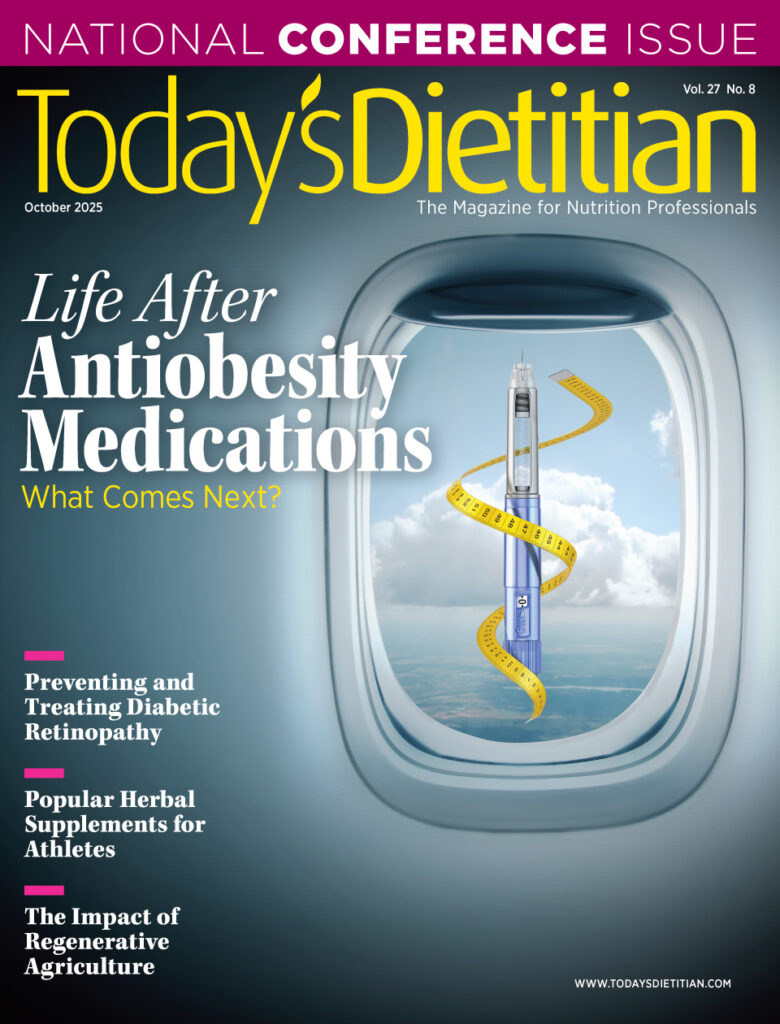By David Yeager
It’s been said that knowledge is power, and nutrition professionals are hoping that the new FDA regulations expanding the availability and accessibility of nutrition information in restaurants will empower consumers to make more healthful choices and make a greater dent in America’s obesity epidemic.
The regulations will require restaurants and similar retail food establishments—such as convenience stores and grocery stores with 20 or more locations operating under the same name and selling the same or similar menu items across their locations—to display calorie counts for the food they serve clearly and prominently on menus, menu boards, and drive-thru displays.1 Calorie counts also must be displayed near menu items in self-service, buffet, and cafeteria lines.1
Additional information, such as calories from fat, total fat, saturated fat, cholesterol, sodium, total carbohydrates, sugars, dietary fiber, and protein, must be available in writing upon request.1 There also must be a menu notice informing consumers that written data are available upon request for standard menu items and a brief, easy-to-understand statement explaining how calories fit into a daily diet.1 Vending machine options and some alcoholic beverages must comply as well.1 The regulations will take effect on December 1, 2015.
With obesity affecting 78.6 million (34.9%) Americans and the estimated annual medical cost of obesity at $147 billion and counting,2 the hope is that consumer education will help curtail the obesity epidemic. According to the USDA’s Economic Research Service, Americans get nearly one-third of their calories from foods prepared outside the home, and those foods contain more calories than foods prepared at home.3 They’re also higher in fat and saturated fat and lower in nutrients such as calcium, fiber, and iron.3
Menu labeling has been implemented in some localities, such as New York, Philadelphia, and King County in Washington, but this is the first time it will be implemented nationwide. Joy Dubost, PhD, RD, CSSD, a food scientist and senior director of nutrition at the National Restaurant Association, says, although current research findings are scant, she hopes to see significant behavior changes.
“If we look at the current literature, the results have been mixed in regard to whether menu labeling changes one’s decisions when ordering. Some studies have shown that it’s made an impact, as far as consumer choice, in lowering their calories, and some studies have shown that it has not. The issue, though, with the studies, is that they’re only relevant to local or state regulations, [so] the research to date is rather limited,” Dubost says. “Once the regulations are put in place nationwide, consumers will have exposure to menu labeling on a regular basis from coast to coast, and I think that will then show that there will be an impact on consumer choice.”
Dubost says most larger companies already have started or completed nutrition analyses for their menu items and have begun menu labeling voluntarily, but smaller companies may have a long way to go. In addition to doing nutrition analyses for all their recipes, they will need to ensure the recipes are followed to the letter at each location. Dubost says the regulations offer new career opportunities for dietitians but cautions that RDs must get some experience doing nutrition analyses before they work with a restaurant or retail chain; they will be held accountable for the information they provide by the government agency overseeing the program. Which agency will oversee the program has yet to be determined.
Establishments with fewer than 20 locations have the option of implementing the regulations. Although it will take some time and effort to make the necessary changes, some companies are embracing them. For example, McDonald’s, which began voluntary menu labeling in 2012, supports the new regulations.
“In order for customers to make informed choices, whether visiting McDonald’s or elsewhere, McDonald’s supports a level playing field where all retail establishments offering foods and beverages are subject to the same menu labeling requirements,” says Cindy Goody, PhD, MBA, RDN, LDN, senior director of nutrition and menu innovation at McDonald’s USA. “McDonald’s is in the process of reviewing the new requirements and believes this is a benefit to both the restaurant industry and to customers seeking consistent information about calories.”
As far as dietetic practice is concerned, Dubost sees these regulations as an exciting opportunity to educate consumers. Between 16.9% and 26.3% of calories consumed outside the home come from restaurants alone,4 and she says this information can be used to better illustrate how eating out affects calorie consumption. Dubost believes teaching people how many calories they need per day can go a long way toward improving public health.
“This information is really useful to consumers, if they know what their daily caloric intake should be because, then, when they walk into these establishments, they’ll have a sense of what they’ve eaten that day and what they should or should not be eating,” Dubost says. “And that’s not to say that you can’t have a more indulgent item and factor that in over the course of a week or a month, but I think it’s very empowering for consumers to have that information, and this is a golden opportunity for dietitians to educate consumers about their caloric needs and how eating out can really be part of a healthful lifestyle.”
— David Yeager is a freelance writer and editor based in southeastern Pennsylvania.
1. Federal Register, vol. 79, no. 230, part II: Department of Health and Human Services. US Government Publishing Office website. http://gpo.gov/fdsys/pkg/FR-2014-12-01/pdf/2014-27833.pdf. Published December 1, 2014.
2. Adult obesity facts. Centers for Disease Control and Prevention website. http://www.cdc.gov/obesity/data/adult.html. Updated September 9, 2014.
3. Food-away-from-home. United States Department of Agriculture Economic Research Service website. http://www.ers.usda.gov/topics/food-choices-health/food-consumption-demand/food-away-from-home.aspx. Updated October 29, 2014.
4. Drewnowski A, Rehm CD. Energy intakes of US children and adults by food purchase location and by specific food source. Nutr J. 2013;12:59.


